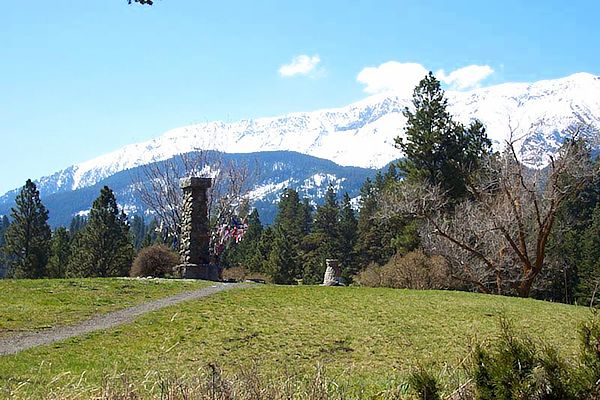Old Chief Joseph (Tuekakas), was leader of the Wallowa Band and one of the first Nez Percé converts to Christianity and a vigorous advocate of the tribe’s early peace with whites, and father of Chief Joseph (also known as In-mut-too-yah-lat-lat or Young Joseph). He was chief of the Nez Perce from 1785—1871.
Modern history first records Joseph, principal chief of the Wallowa band of Nez Perce, in 1834, when he welcomed Captain Benjamin Bonneville as he led the first white men into the Wallowa Valley. Joseph, father to the now more widely known Chief Joseph, was in his late forties at that time.
The Nez Perce treated the Bonneville party to a feast of deer, elk, and buffalo meat, served along with fish and roots, before they settled in for a long talk. Joseph was eager for news of the United States, and Bonneville did his best to sell him on the merits of the American nation.
Missionaries Come to Lapwai
When the missionaries Marcus Whitman and Henry Spalding arrived in Lapwai in 1836, they were intent on converting the Indians to Christianity. Joseph was drawn to the new religion, and moved to distant Lapwai for long periods of time for instruction.
In 1839 Joseph and Timothy were the first Nez Perce to be baptized into the Christian faith. Following his conversion, Joseph and his wife, Khapkhaponimi, who later came to be called Asenoth, married again in their new faith in Spalding’s church. Their children were also baptized, and given Christian names, including a boy, Ephraim, who was likely the future Chief Joseph of Nez Perce War fame.
Following the Whitman tragedy of 1847, the influence of the missions was broken, and Joseph returned to Wallowa Valley. By some accounts he then reverted to his native beliefs, but others describe him as a practicing Christian and friend of the whites for at least another fifteen years.
Treaty Councils
At the Walla Walla Council of 1855, Joseph remained largely quiet, saying only, “I have a good heart, what the Lawyer says, let it be.” When the call for signatures came, Joseph signed along with the other chiefs. But in the years that followed he refused to accept treaty payments, insisting that he had given nothing at Walla Walla and expected nothing in return.
Joseph refused to sign the treaty drawn up at the Lapwai Council in 1863, and by that time the reservation had been so reduced in size that his homelands were now outside its borders. From that point on, Joseph became a leader of the “non-treaty” Nez Perce. He erected boundary monuments to mark his land, and destroyed the Bible given to him by Spalding many years earlier. With this symbolic gesture, Joseph turned his back on the American government.
By 1869, Joseph had gone blind, although he continued to instruct his sons with regard to his perceptions of white men, treaties, and Mother Earth. He told them, “when you go into council with a white man, always remember your country. Do not give it away. The white man will cheat you out of your home.”

Gravesite of Old Chief Joseph in Wallowa Valley, Oregon – See Genealogy Chart
Upon his deathbed, old Joseph told his son:
When I am gone, think of your country. You are the chief of these people. They look to you to guide them. Always remember that your father never sold the country. You must stop your ears whenever you are asked to sign a treaty selling your home. A few years more, and the white man will be all around you. They have their eyes on this land. My son, never forget my dying words. This country holds your father’s body. Never sell the bones of your father and your mother.
Nez Perce War
By 1877, the federal government had tried to force the “non-treaty” bands, including the Wallowa Nez Perce, now led by Young Chief Joseph (Hin-mah-too-yah-lat-kekht), out of their homelands and onto the more restricted reservation. The Indians’ response was the Nez Perce War.
“For decades,” wrote Robert Ignatius Burns, “the Nez Perce were considered as tame Indians, underrated and even mistreated despite their unswerving friendship for the Whites. They won fame and respect only when they went to war.”
Although young Chief Joseph’s brilliance as a war chief won sympathy from the American public, when defeat came to the defiant Nez Perce, they were nevertheless sent into exile at the Colville and Lapwai agencies.
Old Chief Joseph is buried at the fork of the Lostine and Wallowa Rivers on the Nez Perce homelands in what is now Oregon.
Sources:
Drury, Clifford M. Chief Lawyer of the Nez Perce Indians, 1796-1876. Glendale, CA: The Arthur H. Clark Company, 1979.
Nicandri, David L. River of Promise: Lewis and Clark on the Columbia Tacoma: Washington State Historical Society, 1986.
Josephy, Alvin The Nez Perce Indians and the Opening of the Northwest. New York: Houghton Mifflin Company, 1997.
Josephy, Alvin M. The Patriot Chiefs: A Chronicle of American Indian Resistance. New York: Penguin Books, 1976.
Burns, Robert Ignatius. The Jesuits and the Indian Wars of the Northwest. New Haven, CT: Yale University Press, 1966.